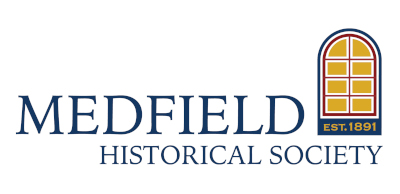Mobile History Tour
The Mobile History Project was launched in 2018 as part of an Eagle Scout Project undertaken by seventeen-year-old Life Scout Caillian Sheehy and backed by the Medfield Historical Society. The ambition of the project was to promote knowledge and awareness of the historic places in Medfield, particularly among the younger generation.
The project involved installing QR code plaques at some of the historic buildings in town. When the QR code is scanned on a mobile phone, it loads a dedicated web page that includes a photograph, a short paragraph, and a brief audio recording that summarizes the history of the building.
Dwight-Derby House
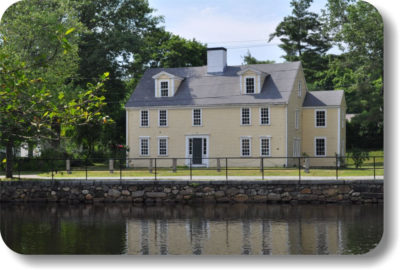
Hello! Welcome to the Dwight-Derby House! This building is often captured in pictures extending its beautiful reflection on Baker’s pond which is right across the street. This house was built in 1651 by Timothy Dwight. For Mr. Dwight’s house to have been built over 350 years ago and last this long is an amazing feat of building construction! In fact, this house is actually one of the ten oldest existing wooden frame houses in the entire country! In 1996, the house was nearly torn down, but fortunately this important piece of Medfield History was purchased by the town, so that you and I can enjoy this community treasure. Thanks to important efforts made by a dedicated group of Medfield volunteers, grants from the Massachusetts Historical Commission, and the National Trust for Historic Preservation, you are able to enjoy the splendor of this house today. The building has been stabilized and partially restored to ensure it will be there for our future generations to enjoy. For more information on this house check out the Dwight-Derby House website.
First Baptist Church
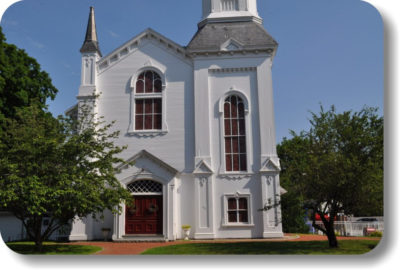
Hi there and welcome to the First Baptist Church! I’m glad you’ve taken the time to visit! This church is an important part of Medfield’s History! Did you know that it’s on the National Register of Historic Places? It’s true, it was added to the register in 2003! This church’s first congregation was established in 1752. It was formally incorporated and given recognition in 1776 under Thomas Gair, its first pastor. The building, the second for the congregation, was first constructed in 1838, and it looked a little different than the building that currently stands before you today. That’s because the church was originally built in the “Greek Revival” architecture style. In 1874, the building was renovated, and transformed into its current “Gothic Revival” appearance, that you are seeing now. The bell was obtained in the 1930s by the congregation to replace their cracked one. It is from a church in Enfield Massachusetts, one of four central Massachusetts towns sacrificed and flooded in the 1930s to create the Quabbin Reservoir.
First Parish UU Church
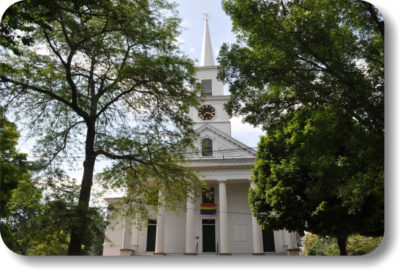
Hi there, and welcome to the First Parish Unitarian Universalist Church! This is the third building on this site. The original was built in 1651, the second in 1706, and this third one in 1789 – all built to serve both as the town’s church and the town’s meetinghouse. This was before the separation of church and state. In the early 19th century, theological differences between Unitarian and Trinitarian factions caused a split. The Unitarians, generally freethinkers who believed in one God at most, remained in this building. The more Christian Trinitarians left to form what has become the UCC. In 1839 this building was extensively remodeled – it was turned 90 degrees to the right, to face Main Street instead of North Street, and the Greek Revival Facade was added. Because of this church’s historic importance as a meetinghouse in Medfield, the historical society holds its five programs here each year.
George Inness House
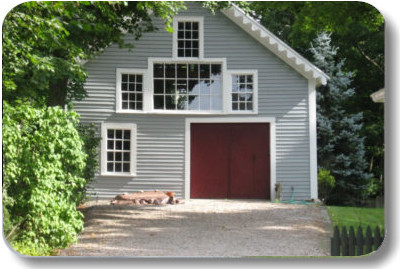
Hello! Welcome to the George Inness Art Studio! This was once the studio of renowned landscape painter George Inness, who was one of America’s foremost artists of his time. Mr. Inness lived in Medfield from around 1860 to 1864. Even though he lived just 4 years in Medfield over 150 years ago, his work is still important and loved today. Many of his works are featured in the Museum of Fine Arts, Boston; the Metropolitan Museum of Art in New York, the Art Institute of Chicago, and many other leading museums. One fun fact is that the Medfield Historical Society possibly possesses a painting from Inness’ early days as an artist. While the authenticity of the piece cannot be validated with 100% certainty, it matches his style. The mysterious painting was gifted to the historical society by a previous owner of the studio. At that time, the studio was and currently is privately owned. The owner claims to have acquired the painting when they purchased the studio, and it does not appear to be a reprint or match any of Inness’ known works. Today, it is housed in the Historical Society’s vault at their headquarters
Kingsbury Grist Mill
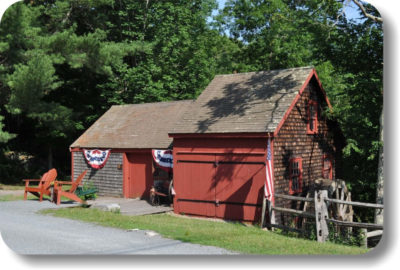
Hi there, welcome to the Kingsbury Grist Mill! Constructed almost 300 years ago, the Kingsbury Grist Mill is a mechanical marvel of Medfield’s history, and I’m glad you could stop by today! A grist mill is a local mill where farmers would bring their grain and receive back ground meal or flour, minus a percentage cut called the “miller’s toll.” When in operation, the Mill had three distinct phases: the first was around 1718, with the operation of the early Clark Mill. The second stage of the Mill’s operation was around 1819 when the present structure was built, and the third stage came in 1889 with the transformation of the grain mill into a saw mill. Currently this site is maintained by the Grist Mill Committee, who hopes to bring the Mill back into operation someday. Approximately 15 years ago, restoration began on this site, with infrastructure improvements. These efforts slowed when the original committee, the Kingsbury Pond Committee, disbanded. Under the more recent Grist Mill Committee, the efforts have restarted, with hopes to make this Mill both functional, and a museum that all of us in Medfield will be able to enjoy.
Medfield Historical Society
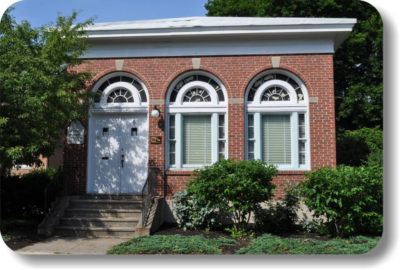
Hello, and welcome to the Medfield Historical Society Building! Standing out from other historical sites in Medfield, this building is an excellent example of Georgian Revival-style architecture on a small scale. Georgian Revival-style generally features full-height round-arched windows and entry, keystones at the center of the brick arches, and the heavy, molded cornice. Originally a millinery shop that sold hats and headwear, the Medfield Cooperative Bank purchased the property in 1922, and removed the shop. They then constructed the current building. In 1968, the headquarters of the Historical Society moved here, and have remained here to this day. The Historical Society leases the property for $1 per year, and assumes building maintenance costs. The building and its collection of Medfield’s history are open to the public year-round, on the first and third Saturday of the month from 10 am to noon and by appointment. One fun fact is that the bank vault is still inside the building today, and it houses many of the Historical Society’s valuable and interesting artifacts!
Lowell Mason House
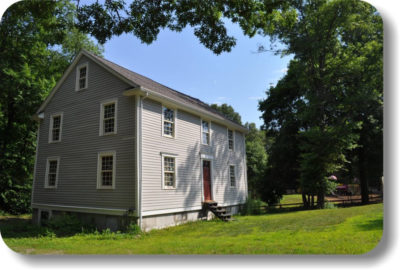
Hello, thanks for stopping by the Lowell Mason House! Perhaps one of Medfield’s most famous people, Lowell Mason lived in this house, which scientific testing has indicated may have been built earlier than 1774, that’s over 240 years ago. Two beams in the attic of the house date to 1650, and 1651, and another dates to 1675, which could have been part of new construction following the devastation of Medfield during King Philip’s War in 1676. As for Lowell-Mason’s own history, he was born in 1792, and grew up in Medfield. He is well known for his hymns, including “Nearer my God to Thee,” which was played by the orchestra during the sinking of the Titanic. He was largely responsible for his role in introducing music into American public schools, and he is considered to be the first music educator in the United States. This house is an important part of our history here in Medfield, and Mason’s contribution to education and music will forever be remembered! Today, the Lowell Mason House is overseen by the Lowell Mason Foundation. Future plans for the house include renovating the interior, landscaping, and a parking lot feasibility study. The foundation also plans to build an entryway to the basement, with convenient access through exterior grounds renovation. They hope that the basement will serve as a music activity space, and that the first floor will serve as a museum with photographs of Mason, personal belongings, and even some of his original sheet music. The plan for the second floor is administrative office space. Ultimately, the Lowell Mason Foundation wants the public to enjoy and use the building for years to come!
Peak House
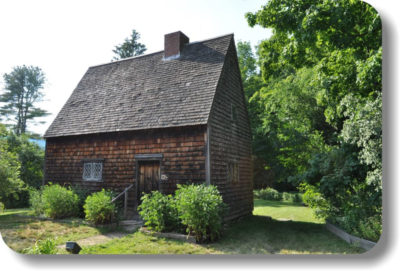
Hello, and welcome to the Peak House, one of the oldest houses in Medfield, and perhaps the most iconic! This is because it is one of the earliest surviving examples of Post-medieval English (Elizabethan) architecture in the United States, and it is on the National Register of Historic Places. Some of the original window glass, imported from England, is still present in the windows! The Peak House was built around 1668 by Benjamin Clark. This house was one of 32 houses that were burned down on February 21, 1676, during the King Philip’s War. After this, it was rebuilt by Benjamin around 1680, at that time the building stood further back than its current location. Through dendrochronology testing, it is believed that the current structure was built in 1711, likely by Benjamin’s son Seth. One interesting fact is that the wood used to build the house was dated to 1492, the year Columbus arrived in the West Indies! Since 1924 the Peak House has been owned by the Historical Society, which uses it for educational purposes, including being open for visitors Sunday afternoons in the summer.
